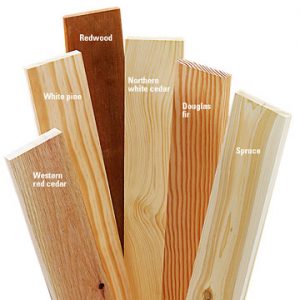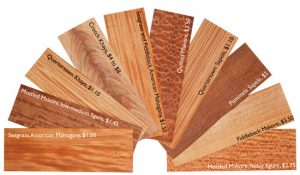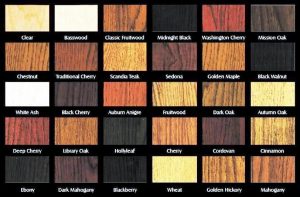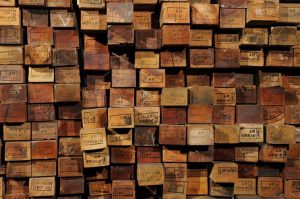Wood
For wood restoration or carpentry works it is necessary to know the various types of wood (or the essence), both for knowing how to process it in the best way and for avoiding substantial mistakes in selecting or in matching the wood to be restored with that to be added to the artifact.
There are many writings that deal with wood processing in depth, but for the purposes of this discussion, an introduction is offered of the essential elements leaving more profound research for other contexts.
Woods are not all the same. They differ in firmness, hardness, flexibility and workability.
Below is a list of wood types, highlighting the main features, which most were (and still are) used for the construction of furniture.
SOFT WOODS They consist mostly of conifers.
Fir There are two kind of firs: white and red, the latter is the most valuable, and it is also used in violin making. Used for the creation of furniture in the ‘Arte Povera’ style, rustic style or as basic element for bonding veneering and more precious wood veneers, it can also be useful as the internal structure of furniture, which is surfaced using more valuable wood. Tender and porous, it is full of knots (the red one), can be easily splintered and due to these characteristics it’s a very hard to get a good finish. It is not suitable for the exterior and for windows and doors, unless previously treated with waterproofing products.
Pine It is available in various types. Mostly reddish colour, is more resinous than fir, it is indicated for building rustic furniture, and resists to moisture. Suitable for outdoor use, for windows and doors, benches, etc.
Birch Clear with subtle grain reddish pattern, it is the hardest wood within the soft wood type. It is used to manufacture common furniture, plywood and veneer of good quality. Not suitable for outdoor use.
Poplar It grows everywhere, but especially along water ways. Its colour is off-white with veins of yellow, easily warps and is attacked by termites. It is not used for producing value furniture, except for internal structures. Not suitable for outdoor use.
HARD AND SEMI-HARD WOODS – 1
Beech It is present everywhere, but it grows especially above 1000 meters. Light-coloured with brown cord and rose veins. Semi-hard wood, suitable for creating support structures, it is easily curvable, suitable for realising curved furniture. It is also used to realise stairs. It is the favourite wood of termites, therefore, when chosen it must be given a protective treatment previous to use. Not suitable for outdoor use.
Ash Hardwood, resilient with colour ranging from white to brown, depending on the age, or pinkish for the Sicilian quality. It is used for all projects that require a hard but elastic wood. Subject to woodworm.
Durmast Oak Grows up to altitudes of 1000 meters, belongs to the oak family. Very hard and strong wood, from yellow-brown colour. It has regular fibers, but is very porous and for this reason it’s hard to sand and to polish it. Frequently used for the construction of furniture, including that of high quality.
Chestnut It grows well up to 900-1000 meters, the colour ranging from yellow to brown and resembles, in the veins, to the oak. Semi-hard wood, if not well matured, tends to shrink and crack. It can be quite easily processed, is rich in tannin and very resistant. Good for outside, it is used for the construction of window frames and shutters, as well as for furniture.
Elm Hard wood, red-brown colour, very porous and heavy, it warps and cracks easily. Resistant to moisture, it is infrequently attacked by termites. Used for the construction of furniture, also as imitation of oak.
HARD AND SEMI-HARD WOODS – 2
Walnut Hard but easy to work with, there are various species and colours, some of these are very valuable and expensive, so its veneers are very used. It can be easily smoothed and polishes well. It is one of the most beautiful woods in Europe. Used extensively for the creation of fine furniture and for turning, it can be used also outside, if well protected.
Olive Tree Very hard wood, compact, yellowish with brown veins, highly sought after and precious, but it needs to be well seasoned. It gives burls of unique beauty, it is used for fine cabinet making and turnery.
Mahogany A hardwood, it is among the most precious woods in particular flaming or red briar. There are various species, but all more or less with the same characteristics. Coming both from Africa and America, it has a reddish colour with golden hues, accentuated by a shellac finish. Resistant to moisture, rarely attacked by woodworm, it’s easily smoothed and polishes well. It is used to fine cabinetmaking, carvings and sculptures.
Cherry tree Precious wood, relatively easy to work with. Red-brown colour, it has an average hardness, is quite easily sanded and takes a good finish, especially with shellac and/or wax. If not very well seasoned it shrinks and warps. It is used for the production of fine furniture and its veneers are very valuable.
Rosewood It comes from South America. It has a purplish-brown colour, is a very hard wood but it is easy to work with, it is perfectly smooth, but it has a very open pore, so it is difficult to polish. It is highly sought after for its beauty, and therefore it is used for luxury cabinetry, especially as veneer.





